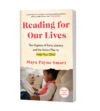Many parents, especially bookish ones, long for their children to fall in love with reading. They read to their kids religiously, awaiting the day when their children take pleasure in selecting and reading books on their own. They hope that curling up in the company of a great book will beat out apps, games, and screen time on their kids’ list of preferred activities.
But, alas, kids often show greater interest in other things. I know that my own daughter’s reading interest and motivation ebbs and flows. There are weeks when she’s more excited about making slime (again), building a pillow fort (again), or even practicing her typing than reading a book. And there are other times when she’s rolling through a series of books, pausing only to tell me the author’s life story and when the next installment is set to drop.
Over the years, I have observed a few factors that seem to boost reading enjoyment. Here’s my best advice for parents who want to encourage their kids to read more on their own.
Shore up their Reading Skills
It’s no fun to read when you struggle with it, so parents of kids who aren’t exhibiting much book love should make sure that there’s not an underlying decoding or comprehension challenge in play.
Take a look at your state’s reading standards to familiarize yourself with grade-level expectations and initiate conversations with your child’s teacher about the students’ strengths and challenges. You could also seek a full-fledged learning evaluation from your school district or an independent provider to discover how your child performs on standardized academic and reading assessments. Detailed evaluations can let you know where your child needs additional support to bring the words on pages to life.
Studies indicate that early reading skill matters for later reading skill and motivation, so make it a priority to secure a strong literacy foundation now.
Supply Interesting Reading Material
Assuming your child can decode and comprehend the texts available to them, the next most important parent action is to give them ample access to interesting (to them) reading material of all kinds—print or digital books, magazines, recipes, lists, instruction manuals—whatever they’ll read attentively. Along with skill, enjoyment is great fuel for reading volume, so stock up on material related to your child’s interests.
One of my favorite examples of this approach is a parent who bought Minecraft books to complement a child’s obsession with the game. “I’ve found that far from increasing time spent on Minecraft, getting your Minecraft fan a book about Minecraft seems to actually have no other effect than to increase the time they spend reading,” the parent observed. “With enthusiasm. As in, I don’t even have to nag them to read. They, gulp, seem to actually WANT to read.”
Epic Digital library is a great choice for families in need of fresh reading material. This kid-focused library offers thousands of ebooks in an ad-free, immersive environment for children 12 and under.
Remember, it’s never the time to force your literary tastes on your child. As long as the content they enjoy isn’t racist, violent, or otherwise objectionable, let them read what they want on their own time, because that literacy practice can boost their reading fluency, vocabulary, and stamina. This is what I tell myself when my daughter is more into magazines and books based on her favorite TV shows than the children’s literature I prefer.
Make it Social
I’ve witnessed firsthand how my daughter’s reading enjoyment is enhanced by factors beyond the book itself—like who shared it with her or who else is reading or talking about it. In kindergarten, she read every available installment of The Owl Diaries because her friends were reading the series too. They had a little book club, traded copies, and shared the excitement of tackling their first chapter books together. I’m convinced that the community around the book kept her reading the series longer than the plot or characters alone would have.
Do any of these strategies resonate with you? What have you tried to boost your child’s interest in reading and how did it work?


